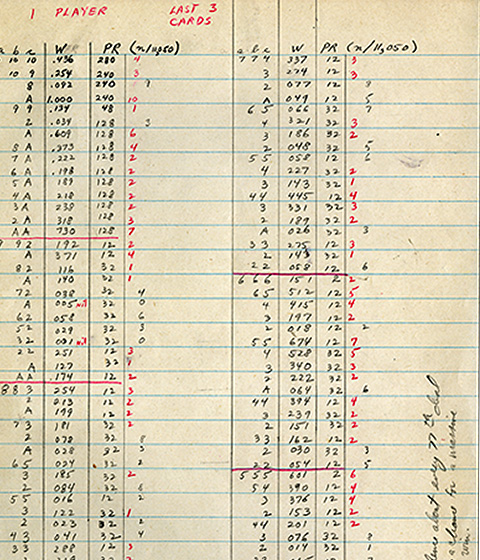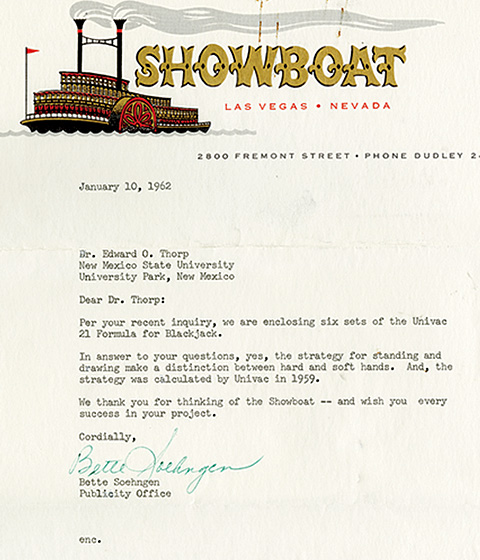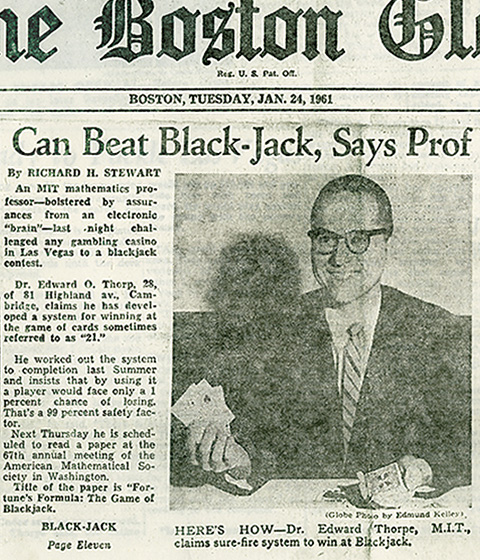“For me blackjack was a game of math, not luck.”
Edward O. Thorp. A Man for All Markets: From Las Vegas to Wall Street, How I Beat the Dealer and the Market. Random House Publishing Group, 2017. Page 93.

Roger R. Baldwin. Journal of the American Statistical Association. Vol. 51. No. 275. September 1956.
The Optimum Strategy in Blackjack.
Edward O. Thorp read this article before a seminal trip to Las Vegas in 1958. He condensed the main features of the strategy onto a card that fit into the palm of his hand and played blackjack for the first time. This experience got him hooked on the game. Thorp wrote, “The atmosphere of ignorance and superstition surrounding the blackjack table that day had convinced me that even good players didn’t understand the mathematics underlying the game. I returned home intending to find a way to win.” Edward O. Thorp. A Man for All Markets: From Las Vegas to Wall Street, How I Beat the Dealer and the Market. Random House Publishing Group, 2017. Page 62.
“A Favorable Strategy for Twenty-One.”
Edward O. Thorp published his discovery in the Proceedings of the National Academy of Sciences. This journal required a member of the academy to approve and forward the author’s work, which led to Thorp’s introduction to the mathematician, Claude Shannon, who was also at Massachusetts Institute of Technology (MIT). Thorp and Shannon would later collaborate and create a wearable computer to beat the game of roulette.
Thorp also presented his findings at the American Mathematical Society in Washington D.C. in January 1961. His talk, “Fortune’s Formula: The Game of Blackjack” created quite a stir.
Collage of Edward O. Thorp’s formulas to figure out blackjack odds and strategy. 1962.
As Edward O. Thorp began to delve into the theory of probability, he realized he could beat the game of blackjack and he could prove it. “I started with the fact that the strategy I had used in the casino assumed that every card had the same chance of being dealt as any other during play… But I realized that the odds as the game progressed actually depended on which cards were still left in the deck and that the edge would shift as play continued, sometimes favoring the casino and sometimes the player.” Edward O. Thorp. A Man for All Markets: From Las Vegas to Wall Street, How I Beat the Dealer and the Market. Random House Publishing Group, 2017. Page 67.
In 1959, while Thorp was working at the Massachusetts Institute of Technology (MIT), he began working on his blackjack theory using an IBM 704 computer to run through 34 million different combinations in which the cards could be dealt. He concluded that given a bet limit of $500, the game could be consistently beaten at the rate of $125 an hour.

Courtesy of Edward O. Thorp. Photo by Don Cravens. Life Magazine.
Edward O. Thorp playing blackjack at the Tropicana Hotel, November 19, 1963.
Letter and “UNIVAC” cards from The Showboat Casino in Las Vegas, January 10, 1962.
“When starting my calculations... I sent an inquiry to twenty-six Nevada casinos. My object was to learn how the rules varied from one establishment to another, in particular to see if some places had rules even more favorable than usual. Thirteen of the twenty-six casinos were kind enough to reply to an ignorant academic.” Edward O. Thorp. A Man for All Markets: From Las Vegas to Wall Street, How I Beat the Dealer and the Market. Random House Publishing Group, 2017. Page 81.
“What intrigued me was the possibility that merely by sitting in a room and thinking, I could figure out how to win.”
Edward O. Thorp. A Man for All Markets: From Las Vegas to Wall Street, How I Beat the Dealer and the Market. Random House Publishing Group, 2017. Page 66.
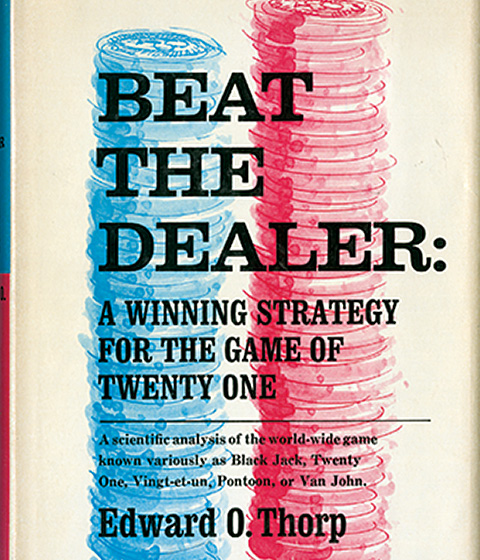
Edward O. Thorp. Random House, 1962.
Beat the Dealer: A Winning Strategy for the Game of Twenty One.
Edward O. Thorp published his discovery in the Proceedings of the National Academy of Sciences. This journal required a member of the academy to approve and forward the author’s work, which led to Thorp’s introduction to the mathematician, Claude Shannon, who was also at Massachusetts Institute of Technology (MIT). Thorp and Shannon would later collaborate and create a wearable computer to beat the game of roulette.
This book mathematically proved that the casino advantage in blackjack could be overcome by card counting. Beat the Dealer would go on to sell over one million copies and profoundly change the casino industry. Edward O. Thorp’s strategy exposed the innate vulnerability of the game and made blackjack a test of ability, not luck.
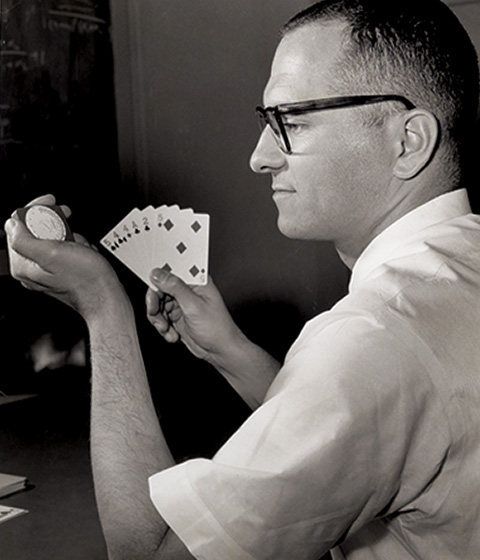
Courtesy of Edward O. Thorp.
Prototype of the Beat the Dealer device + Picture of Edward O. Thorp holding device.
Edward O. Thorp published his discovery in the Proceedings of the National Academy of Sciences. This journal required a member of the academy to approve and forward the author’s work, which led to Thorp’s introduction to the mathematician, Claude Shannon, who was also at Massachusetts Institute of Technology (MIT). Thorp and Shannon would later collaborate and create a wearable computer to beat the game of roulette.
This hand-held gadget is a prototype. It can count multiple cards and provide “touch” read out capabilities.
Outcome of conference presentation.
“The national AP wire service ran Tom Wolfe’s story, causing thousands of letters and phone calls to pour into the MIT Math Department...Before I gave my talk at the meeting, I hadn’t envisioned the clamor and publicity that would follow. Instead, I’d expected scholars to look at my work, be very surprised at the results, and eventually agree that it was correct. But rather than this happening in a quiet, slow-paced academic way, I was besieged by strangers all wanting a piece of me.” Edward O. Thorp. A Man for All Markets: From Las Vegas to Wall Street, How I Beat the Dealer and the Market. Random House Publishing Group, 2017. Pages 82–83.
Simple Explanation of the Game of Blackjack.
Blackjack is the American variant of a globally popular banking game known as Twenty-One. The objective of the game is to beat the dealer in one of the following ways:
- Get 21 points on the player’s first two cards (called a blackjack);
- Reach a final score higher than the dealer without exceeding 21; or
- Let the dealer draw additional cards until their hand exceeds 21
Publicity After Book Published.
- Edward O. Thorp. A Prof Beats the Gamblers. Atlantic Monthly. June 1962. Page 41-46.
- Author unknown. Games: Beating the Dealer. Time Magazine. January 25, 1963. Page 70.
- Paul O’Neil. The Professor Who Breaks the Bank. Life Magazine. March 27, 1964. Page 81.
- David E. Scherman. It’s Bye! Bye! Blackjack. Sports Illustrated. January 13, 1964. Page 19.
“I launched an army with Beat the Dealer. Thus continued the great blackjack war between casinos and the players that still rages, more than fifty years after the invention of card counting.”
Edward O. Thorp. A Man for All Markets: From Las Vegas to Wall Street, How I Beat the Dealer and the Market. Random House Publishing Group, 2017. Page 11.
Simple 5 Count Strategy for One Deck
What to Count:
- Start with the count of 0.
- For each 5 observed add +1.
- For each ACE observed subtract -1.
- Explanation: If the count is greater than or equal to 2, double your bet. If the count is less than 1, make the minimum bet.
- Question: Given this scenario, would you bet more or less on your next hand?
“All strategies apply to multiple decks and various numbers of remaining cards simply by dividing the cards by the player’s guess as to the equivalent number of decks of cards not yet played. Example: six deck game looks like about four decks worth of cards (208) left. Divide count by 4 to get “true” or corrected count.” - Edward O. Thorp.


